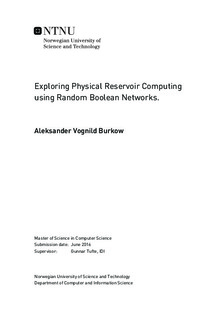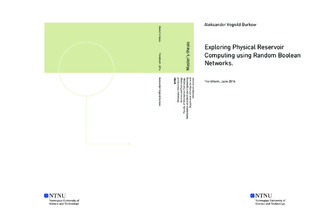| dc.description.abstract | Reservoir computing (RC), a relatively new approach to machine learning,
utilizes untrained recurrent neural networks as a reservoir of dynamics to pre-process some temporal task,
making it separable with a linear readout layer.
Potentially any sparsely connected network containing feedback loops can be a reservoir.
One such network is the random Boolean network (RBN),
which has previously been used in a reservoir computing setting.
Reservoir computing can be performed with physical or simulated reservoirs.
When using a physical reservoir for computation, as in evolution-in-materio,
one is often restricted in how one can perturb and read out the underlying substrate.
In this thesis, the following properties of RBN RC devices are investigated and related to physical reservoirs:
How task difficulty affects required reservoir size,
how much reservoir perturbation is optimal,
the performance of reservoir subsets,
and the relationship between an RBNs attractors and its performance as a reservoir.
Experiments confirm that the required reservoir size increases with the difficulty of the task at hand,
with the largest factor being how many bits of input the reservoir is required to remember.
Simulation of RBN RC systems can therefore aid in deciding the optimal size of physical reservoirs,
given a bridge between the computational power of the reservoir and RBNs can be deduced.
Optimal reservoir perturbation is found to lie at roughly 50\% of the size of the reservoir for RBNs with $K=3$.
When using smaller slices of a reservoir for computation,
lower amounts of total perturbation will be required as long as these perturbations are located within the same topological area.
Results also show that subsets of larger reservoirs will perform at least as well as a separate reservoir of equal size.
Any interference from the unused parts of the reservoir is either minimal or slightly positive.
Finally, no relationship is found between the attractors of a RBN and its performance in a RBN RC system.
It can therefore not be used for guiding the construction of accurate RBNs. | |

